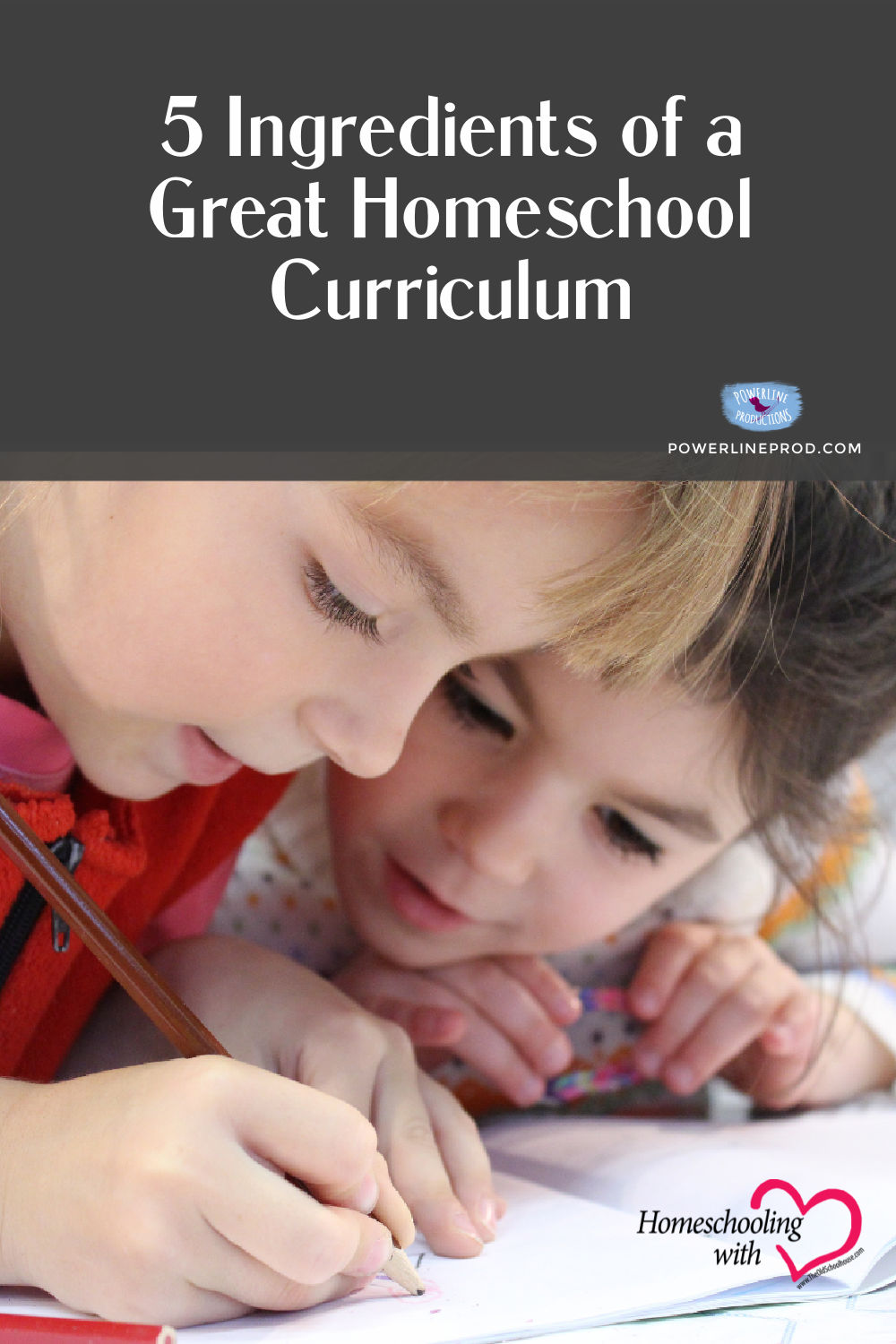5 Ingredients of a Great Homeschool Curriculum


There are so many amazing homeschooling products out there! How can you find the curriculum that works for your family? I have been taken in by the glitz of packaging only to discover that the content didn’t go very deep. Over the many years of homeschooling, I have an “inner checklist” I use to determine if something will work for my children.
Here are the 5 things I look for when I’m shopping for curriculum.
Worldview
I look for curriculum that matches my worldview.
As a Christian, I have a biblically based worldview. I believe the Bible is true and applies to all areas of life. I want to show my children how God’s Word relates to every subject we study.
This means that all life has value, there are moral absolutes, and all people are accountable to God for their words and deeds. Teaching my children from a Christian perspective is easier if my curriculum is written from a Christian worldview.
For more information on worldview, listen to my podcast: What is Your Worldview? that explains 6 different worldviews popular in our world today.
When Worldviews Collide is another podcast that helps parents and teens recognize worldviews that contrast with Christianity.
Content
Content is important to me. I don’t want busy work. I want my children to learn with depth. Going through the Table of Contents in a book or course often gives me a good idea of the breadth of what is taught. Reading a chapter gives me an idea of the depth.
There are certain topics that should be contained in an American history course like the Great Awakening, American Revolution, Constitution, Pioneers Moving Westward, Slavery, and other foundations. I get excited when a history textbook goes deeper into giving biographical sketches on famous Americans, mentions businesses and their beginnings, and zeros in on a particular town or city in addition to the basics.
If I’m looking for a math curriculum, I know that learning math consists of understanding how to do a problem and being consistent in working the problem and getting the right answer. So, I want to know if concept explanations are easy-to-understand for my children. Next, I want to see that there are plenty of practice problems so they can become proficient.
In a science curriculum, I want to see clear, easy-to-understand explanations along with hands-on labs, experiments, and sketching/labeling.
I make lists of what I am looking for when it comes to content. If I can’t find everything in one curriculum, I will often combine two separate ones.
Finally, wholesomeness and purity are important to me when it comes to content. I don’t want to see dirty words, cut-downs, or degradation of any kind. Instead, I look for word usage that is age-appropriate, enjoyable to read, and will enrich my children’s vocabulary.
Fun Factor
The fun factor matters. After all, we need to smile and laugh when we do school. Adding art and crafts or music goes a long way in providing fun for the whole family.
We love to add games or cooking to our history and geography studies. If our chosen curriculum doesn’t have it, we add those things in ourselves—I usually add ideas next to the Table of Contents or lesson plans.
In our home, things that we consider “Fun Factor” are:
- Cooking/Baking
- Timelines
- Movies/TV Shows
- Games
- Hands-On Activities
- Creating Skits, Radio Dramas, Commercials
- Mapping
- Living Books
- Historical Fiction
- Geographical Fiction
- Writing Poems
- Music
- Art
- Crafts
- Dioramas
- Posters/Brochures/Booklets
- Lapbooking
- Blogging about It
- Dressing Up
- Travel
- Field Trips
- Writing a Story
- Games
- Sports
Usability
What is easy to use for me may not be the same thing that makes something easy to use for you. So, look though a week to a month’s worth of studies in curriculum you are considering.
Is it clear enough for you to know how to use it for maximum potential?
Does it seem workable or does the preparation overwhelm you?
Cost Value
Including cost value in my shopping doesn’t mean that I get the cheapest thing out there. That can end up costing me more in the long run.
Cost value to me means that it is worth the price I will pay for it. That is personal and different for each person.
- Am I getting what I pay for?
- If this is core curricula, is it worth the price?
- If this is supplemental (like timeline, cookbook, literature, map), do I really need it? And is it worth the price?
For help with saving money, read 7 Secrets to Help You Save Big on Homeschool Curriculum.
As you can see, there are some basic things to consider, and they really make shopping easier for me. I love to go to homeschool conventions where I can actually hold and look through curriculum and living books. I often find that will be the deciding factor for me when it’s down to two or three choices.
For more information on choosing curriculum, read my blog post 8 Steps to Choose the Best Curriculum for Your Family.
I hope this helps you as you are facing the dilemma of what curriculum to purchase for next year.
Until next time, Happy Homeschooling,
Warmly,
Meredith Curtis
Meredith Curtis, homeschooling mom, writer, speaker, and publisher, loves to encourage families in their homeschooling adventure. She is the author of HIS Story of the 20th Century series, Travel God’s World Geography, American History Timeline, and Americana Newspaper Reporting. You can check out her books, curricula, unit studies, and Bible studies at PowerlineProd.com. Read her blogs at PowerlineProd.com and listen to her at Finish Well Radio.















































